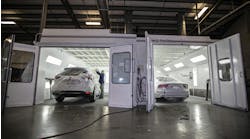The numbers may seem surprising to some
shops, but Steve Trapp said improvement in paint products, equipment and production systems have raised the benchmark for the number of jobs that could flow through your paint booth each day.
“We now have gotten our booth window down to 72 minutes,” said Trapp, collision services development manager for Axalta (formerly DuPont) Performance Coatings. “Instead of 90 to 95 minutes like it used to be for booth cycle, we’ve gotten it down into the 70s. So in an 8-hour day, you should be able to paint seven cars.”
Extrapolate that out, he said, and it comes to 140 jobs a month per booth. Work a staggered shift to run the booth 12 hours instead of eight and you should be able to finish 11 cars a day or 220 a month. With a full second shift, it’s 260 jobs per month with just the one booth.
“We’ve been able to see this pretty consistently with some of the bigger shops,” Trapp said.
If your shop is not close to that level of production, you’re not alone. Steve Feltovich, manager of business consulting services for Sherwin-Williams Automotive Finishes, said his company’s production benchmark is also six or seven cars per day per booth, but the industry average nationwide is far below that.
“It’s right about 3.1 units per booth per day,” Feltovich said. “So our run rate is about 50 percent of what it should be on a national average. I’ve seen shops that are even below that, believe it or not, usually because they have too much equipment.”
How can you move your shop’s paint department closer to six or seven jobs per day? Paint company representatives say it takes a combination of the right equipment, processes and talent.
The right equipment
As the shop facility planning manager for Akzo Nobel Coatings, Rick Farnan says improving booth car count has to begin with having the right booth being used in the most efficient manner. He said a full-downdraft booth, for example, offers better air and heat flow throughout than a cross-flow or semi-downdraft.
“In a downdraft booth, depending upon the length and width of the floor exhaust area, the air flow through the cabin should be uniform from front to back and side to side.” Farnan said. “In a semi-downdraft, the area below the ceiling filters near the floor is subject to little or no air movement. So you tend to get better air flow and drying on one end of the vehicle than the other.”
A drive-through booth is generally ideal, he said, because cars ready to be sprayed can be staged just in front of the booth, rather than having to wait for the car inside to be backed out.
Farnan said location should be a consideration when making a decision about booth burner design. Direct-fired burners will deliver a constant temperature regardless of how cold it gets outdoors; indirect-fired burners are subject to temperature swings when used in extremely cold climates.
“In direct-fired units, the burner is basically maintenance-free and should last a lifetime,” Farnan said. “In indirect-fired units, the drum or heat exchanger is exposed to constant temperature swings, and will likely need to be replaced.”
The right process
But there’s certainly plenty that shops can do to boost their booth’s throughput aside from upgrading to a better booth. Process can be just as important as equipment, the paint company representatives said.
Sherwin-Williams’ Feltovich said scheduling can impact how much work the paint shop can get through the booth in a week.
“The age-old pattern of scheduling all cars in on Monday and out on Friday sets you up for mass chaos in the paint shop one or two days a week, and under-utilization of the booth on other days,” Feltovich said. “So my first recommendation is to schedule cars in every day of the week.”
Next, he said, get ahead of any potential bottlenecks by identifying colors and specialty coatings on each vehicle during damage analysis.
“Don’t wait until the car shows up in the paint shop,” he said. “Also, inspect your paint and material inventory daily to make sure you have the products on hand for the cars you’re painting in the coming week. In some shops, it’s more of a ‘We’ll deal with that when we get to it,’ process, and that’s not setting yourself up for success.”
Feltovich also said shops should get away from cutting in or painting some parts for a job one day, then spraying the rest of the job on another.
“Move toward painting everything at one time, for the entire job,” Feltovich said. “There are some cases that will be an exception to that rule, but try to set each job up so everything pertaining to that job can be refinished at one time in one trip through the booth.”
Axalta’s Trapp said some seemingly simple things, like having the right type of racks, can help boost the amount of work that can be processed through the booth. Don’t bring parts into the booth on the same racks on which they were prepped, Trapp cited as an example, because that will introduce sanding dust into the booth. Instead, he suggests, transfer fully-prepped parts to flipper-style racks that are used only inside the booth and that make the parts quick to maneuver during spraying.
Shops are increasingly painting parts off the vehicle, Trapp said, which enables them to have parts for multiple jobs in the booth at the same time – if the booth airflow is properly balanced. If the booth is equipped with a variable frequency drive to balance airflow in and out based on what is in the booth, Trapp said, make sure painters are trained on its use. Getting the booth’s airflow balanced will also expand the area within the booth that can be used, and will also help eliminate cold spots in the cabin that extend baking times.
Feltovich agreed that painting parts off the vehicle is the way to go.
“Some shops are even removing parts at their own expense to paint them off the vehicle,” Feltovich added. “A shop at a training class I was doing recently brought up that they are removing panels to blend them off the car. They’re not getting paid to remove them, but they’re doing it because it speeds up the process. It’s really increased their production rate per day, and you get a really undetectable refinish when it’s done.”
Maximize throughput
Bryan Robinson, North American manager of national accounts for PPG Automotive Refinish, said he’s seen shops improve booth car count simply by ensuring there’s always another job ready to move into the booth as one comes out. This may require using more of a team approach.
“In order to always have a vehicle ready to go into the booth, you may have to pull a guy off priming in order to help get another one prepped,” Robinson said. “That just makes sense when you consider that every hour you look at that booth sitting empty, presuming you have the inventory of work to put in there, it’s costing you $2,000.”
Trapp said really good lighting in the prep area will help ensure the jobs staged to move next into the booth are truly ready to be sprayed.
“You want to be able to see any shiny spots that need to be handled,” he said. “You want to catch it outside the booth so you’re not bringing any of those contaminants or doing any of those processes inside the booth.”
Robinson said general cleanliness improves paint department profits by reducing time spent denibbing and buffing.
“For example, the vehicle should be cleaned before it comes into the shop,” Robinson said. “Otherwise that dirt travels with that car all the way through the process and into the booth. Now you’re paying guys to go back once it’s been painted and get the dirt out of the paint. Well, who put it there? It’s not in the can of paint. It’s because of the environment you’re in, and it’s costing you a lot of money, time and energy.”
“Three things – personal protective equipment for the people, a clean booth and a clean mixing room – lead to less buffing,” Trapp agreed. “If the painter can just go in and paint, paint, paint, and not buff, buff, buff, he can keep the flow going. But if he or someone has to stop every time to buff, you lose the resource and you can’t put as much through. We’re basically taking shops that were 80 percent buff down as low as 15 percent buff. I’ve never seen anyone get to zero, but it’s still a huge improvement.”
Trapp and the others said improvements such as these are the key to a shop boosting a booth’s car count.
Measuring your booth’s ‘cycle time’
Shops have long measured cycle time in terms of “keys to keys:” The average number of days from when the customer dropped off their damaged vehicle to when they get back their keys and repaired vehicle.
But Joe Skurka, manager of OEM and industry relations for BASF Automotive Refinish, said shops may want to measure – and work to improve – a subset of that: booth cycle time.
“I typically hear people talk about how many cars a day can you get through the booth,” Skurka said. “That’s usually the productivity measure, and that’s a valid measurement, for sure.”
But, he said, shops can also check how they are doing by dividing the number of repair orders (ROs) processed in a week or month by the number of hours the shop is working.
For example, he said, Shop A has one booth (running 8-hour days) and processed 89 ROs in a month with 21 weekdays. Divide 168 hours (8 hours times 21 days) by 89 to get a booth cycle time of 1.9 hours per RO.
Or Shop B has two booths working 10 hours a day and processed 246 jobs in that same 21 day month. Divide 420 hours (20 hours a day – 10 per booth – times 21 days) by 246 to get a booth cycle time of 1.7 hours per RO.
Skurka said BASF suggests a booth cycle time benchmark of 1.6 to 1.8 hours per RO; the lower the number, the better.
Time to add a booth?
Adding a booth is no small investment, so how can you know it’s the best solution to an apparent bottleneck in your production?
“Consider extending your paint shop hours first,” Skurka said. “You can have your booth running 10 or 12 hours a day before you’re at all maximizing the use of your equipment.”
Akzo Nobel’s Rick Farnan said when he is planning shop layouts, he keeps a simple “10-2-1” formula in mind. For every 10 metal shop stalls, he said, a shop should have two prep stations and one booth. Fewer body stalls, he said, and use of the equipment won’t be maximized; too many body stalls, and the booth becomes a bottleneck.
Farnan said that before adding another booth, he recommends considering a closed-top, open-front (CTOF) prep station unit with a minimum of two solid vertical walls and a pressurized ceiling plenum. They can be used for spraying and drying of primers as well as basecoats and clearcoats. The air quality is similar to an enclosed booth, and they can handle both vehicles and small parts.
“So if my shop has 10 body stalls and one booth, and I have too much work in my paint shop that I can’t get out, should I consider a CTOF?” Farnan said. “Because of its flexibility, it can handle multiple jobs and reduce the workload on your single booth.”
Subscribe to ABRN and receive articles like this every month….absolutely free. Click here.






